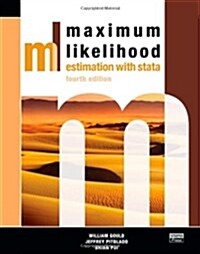
Maximum likelihood estimation with Stata
- 판사항
- 4th ed
- 발행사항
- College Station, Tex: Stata Press, 2010
- 형태사항
- xxii, 352 p. : ill.; 24cm
- ISBN
- 9781597180788
- 청구기호
- 413.8 G698m
- 서지주기
- Includes bibliographical references (p. [343]-345) and indexes
소장정보
| 위치 | 등록번호 | 청구기호 / 출력 | 상태 | 반납예정일 |
|---|---|---|---|---|
이용 가능 (1) | ||||
| 1자료실 | 00015091 | 대출가능 | - | |
- 등록번호
- 00015091
- 상태/반납예정일
- 대출가능
- -
- 위치/청구기호(출력)
- 1자료실
책 소개
Maximum Likelihood Estimation with Stata, Fourth Edition is written for researchers in all disciplines who need to compute maximum likelihood estimators that are not available as prepackaged routines. Readers are presumed to be familiar with Stata, but no special programming skills are assumed except in the last few chapters, which detail how to add a new estimation command to Stata. The book begins with an introduction to the theory of maximum likelihood estimation with particular attention on the practical implications for applied work. Individual chapters then describe in detail each of the four types of likelihood evaluator programs and provide numerous examples, such as logit and probit regression, Weibull regression, random-effects linear regression, and the Cox proportional hazards model. Later chapters and appendixes provide additional details about the ml command, provide checklists to follow when writing evaluators, and show how to write your own estimation commands.
This edition explains how to compute maximum likelihood estimators that are not available as prepackaged routines. The book introduces the theory of maximum likelihood estimation with particular attention on the practical implications for applied work. It then describes each of the four types of likelihood evaluator programs and provides numerous examples, such as logit and probit regression, Weibull regression, random-effects linear regression, and the Cox proportional hazards model. The text also includes additional details about the ml command, provides checklists to follow when writing evaluators, and shows how to write your own estimation commands.
목차
THEORY AND PRACTICE
The likelihood-maximization problem
Likelihood theory
The maximization problem
Monitoring convergence
INTRODUCTION TO ml
The probit model
Normal linear regression
Robust standard errors
Weighted estimation
Other features of method-gf0 evaluators
Limitations
OVERVIEW OF ml
The terminology of ml
Equations in ml
Likelihood-evaluator methods
Tools for the ml programmer
Common ml options
Maximizing your own likelihood functions
METHOD lf
The linear-form restrictions
Examples
The importance of generating temporary variables as doubles
Problems you can safely ignore
Nonlinear specifications
The advantages of lf in terms of execution speed
The advantages of lf in terms of accuracy
METHODS lf0, lf1, AND lf2
Comparing these methods
Outline of evaluators of methods lf0, lf1, and lf2
Summary of methods lf0, lf1, and lf2
Examples
METHODS d0, d1, AND d2
Comparing these methods
Outline of method d0, d1, and d2 evaluators
Summary of methods d0, d1, and d2
Panel-data likelihoods
Other models that do not meet the linear-form restrictions
DEBUGGING LIKELIHOOD EVALUATORS
ml check
Using the debug methods
ml trace
SETTING INITIAL VALUES
ml search
ml plot
ml init
INTERACTIVE MAXIMIZATION
The iteration log
Pressing the Break key
Maximizing difficult likelihood functions
FINAL RESULTS
Graphing convergence
Redisplaying output
MATA-BASED LIKELIHOOD EVALUATORS
Introductory examples
Evaluator function prototypes
Utilities
Random-effects linear regression
WRITING DO-FILES TO MAXIMIZE LIKELIHOODS
The structure of a do-file
Putting the do-file into production
WRITING ADO-FILES TO MAXIMIZE LIKELIHOODS
Writing estimation commands
The standard estimation-command outline
Outline for estimation commands using ml
Using ml in noninteractive mode
Advice
WRITING ADO-FILES FOR SURVEY DATA ANALYSIS
Program properties
Writing your own predict command
OTHER EXAMPLES
The logit model
The probit model
Normal linear regression
The Weibull model
The Cox proportional hazards model
The random-effects regression model
The seemingly unrelated regression model
APPENDIX A: Syntax of ml
APPENDIX B: Likelihood-evaluator checklists
APPENDIX C: Listing of estimation commands
References
Author Index
Subject Index
